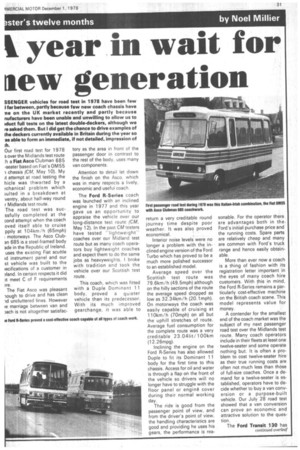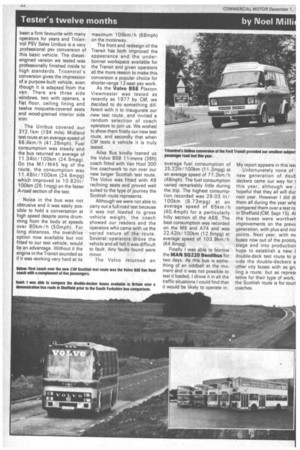k year in wait for aew generation
Page 33

Page 34

If you've noticed an error in this article please click here to report it so we can fix it.
Our first road test for 1978 s over the Midlands test route :h a Fiat Asco Clubman 685 -seater based on Fiat's 0M55
chassis (CM, May 10). My it attempt at road testing the hide was thwarted by a 3chanical problem which -iulted in a breakdown at ventry, about half-way round r Midlands test route.
The road test was sucssfully completed at the z:ond attempt when the coach oved itself able to cruise ppily at 104km /h (65mph)
motorways. The Asco Cluban 685 is a steel-framed body ade in the Republic of Ireland. uses the existing Fiat scuttle id instrument panel and our st vehicle was built to the iecifications of a customer in aland. In certain respects it did A meet C of F requirements 3re.
The Fiat Asco was pleasant lough to drive and has clean -id uncluttered lines. However ie marriage between van and aach is not altogether satisfac
tory as the area in front of the passenger door in contrast to the rest of the body, uses many van components.
Attention to detail let down the finish on the Asco, which was in many respects a lively, economic and useful coach.
The Ford R-Series coach was launched with an inclined engine in 1977 and this year gave us an opportunity to appraise the vehicle over our long-distance test route (CM. May 12), In the past CM testers have tested "lightweight" coaches over our Midland test route but as many coach operators buy lightweight coaches and expect them to do the same jobs as heavyweights, I broke with tradition and took the vehicle over our Scottish test route.
This coach, which was fitted with a Duple Dominant 11 body, proved a quieter vehicle than its predecessor. With its much improved gearchange, it was able to return a very creditable round journey time despite poor weather. It was also proved economical.
Interior noise levels were no longer a problem with the inclined engine version of the Ford Turbo which has proved to be a much more polished successor to an established model.
Average speed over the Scottish test route was 79.6km /h (49.5mph) although on the hilly sections of the route the average speed dropped as low as 32.34km /h (20.1mph). On motorways the coach was easily capable of cruising at 110km /h (70mph) on all but the uphill stretches of route. Average fuel consumption for the complete route was a very creditable 23.041it/ 100km (12.26mpg).
Inclining the engine on the Ford R-Series has also allowed Duple to fit its Dominant 11 body for the first time to this chassis. Access for oil and water is through a flap on the front of the vehicle so. drivers will no longer have to struggle with the floor panel or engine cover during their normal working day.
The ride is good from the passenger point of view, and from the driver's point of view, the handling characteristics are good and providing he uses his gears, the performance is rea
sonable. For the operator there are advantages both in theFord's initial purchase price and the running costs. Spare parts are relatively cheap and many are common with Ford's truck range and hence easily obtainable.
More than ever now a coach is a thing of fashion with its registration letter important in the eyes of many coach hire customers. With this in mind, the Ford R-Series remains a particularly cost-effective machine on the British coach scene. This model represents value for money.
A contender for the smallest end of the coach market was the subject of my next passenger road test over the Midlands test route. Many coach operators include in their fleets at least one twelve-seater and some operate nothing but. It is often a problem to cost twelve-seater hire as their true running costs are often not much less than those of full-size coaches. Once a demand for a twelve-seater is established, operators have to decide whether to buy a van conversion or a purpose-built vehicle. Our July 28 road test showed that a van conversion can prove an economic and attractive solution to the question.
The Ford Transit 130 has
been a firm favourite with many operators for years and TriCentral PSV Sales Unibus is a very professional psv conversion of this basic vehicle. The dieselengined version we tested was professionally finished inside to high standards. Tricentrol's conversion gives the impression of a purpose-built vehicle, even though it is adapted from the van. There are three side windows, two with openers, a flat floor, ceiling lining and twelve moquette-covered seats and wood-grained interior side trim.
The Unibus covered our 312.1km (194 mile) Midland test route at an average speed of 66.4km /h (41.28mph). Fuel consumption was steady and the bus returned an average of 11.341it/100km (24.9mpg). On the M1 / M 4 5 leg of the route, the consumption was 11.481it/100km (24.6mpg) which improved to 10.821it/ 100km (26.1 mpg) on the faster A-road section of the test.
Noise in the bus was not obtrusive and it was easily possible to hold a conversation at high speed despite some drumming from the body at speeds over 80km /h (50mph). For long distances, the overdrive option now available but not fitted to our test vehicle, would be an advantage. Without it the engine in the Transit sounded as if it was working very hard at its maximum 109km /h (68mph) on the motorway.
The front end redesign of the Transit has both improved the appearance and the under bonnet workspace available for the Transit and given operators all the more reason to make this. conversion a popular choice for shorter-range 12-seat psv work. As the Volvo 658 Plaxton
Viewmaster was tested as recently as 1977 by CM, we
decided to do something dif ferent with it to inaugurate our new test route,, and invited a random selection of coach operators to join us. We wished to show them firstly our new test
route, and secondly that when CM tests a vehicle it is truly tested.
Ailsa Bus kindly loaned us the Volvo B58 11-metre (36ft) coach fitted with Van Hool 300 line coachwork to run over our new longer Scottish test route.
The Volvo was fitted with 49 reclining seats and proved well suited to the type of journey the Scottish route represents.
Although we were not able to. carry out a full road test because it was not loaded to gross vehicle weight, the coach showed our readers and the operators who came with us the varied nature of the route. Several operators drove the vehicle and all felt it was difficult to fault. Any faults found were minor.
The Volvo returned an average fuel consumption of 25.22Iit /100km (11.2mpg) at an average speed of 77.2km /h (48mph). The fuel consumption varied remarkably little during the trip. The highest consumption recorded was 29.03 lit/ 100km (9.73mpg) at an average speed of 65km /h (40.4mph) for a particularly hilly section of the A68. The best consumption was recorded on the M6 and A74 and was 22.42Iit / 100km (12.6mpg) at average speed of 103.9km / h (64.6mpg), Finally I was able to borrow the MAN SG220 Bendibus for two days. As this bus is something of an oddball at the moment and it was not possible to test it loaded, I drove it in all the traffic situations I could find that it would be likely to operate in. My report appears in this isst
Unfortunately none of new generation of douh deckers came our way for 1 this year, although we . hopeful that they all will dur next year. However I did dr them all during the year whE compared them over a test ro in Sheffield (CM, Sept 15). Al the buses were worthwh improvements on the previ( generation, with plus and mur points. Next year, with mi buses now out of the prototy stage and into production hope to establish a new ( double-deck test route to p vide the double-deckers a other city buses with as grL ling a route, but as represi tative for their type of work, the Scottish route is for touri coaches.


































































































































